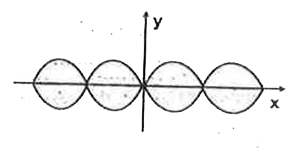The trajectory of a body with two simultaneous, mutually perpendicular oscillations is determined by
x=asin(pωt) (1)
y=bsin(qωt+ϕ) (2)
where x and y are the projections of the body displacement on X and Y axes
For simplicity, assume pω=qω=ω0. Then, the equation of trajectory will be
y2b2+x2a2−2xyabcosϕ=sin2ϕ (3)
which is a general equation of ellipse.
But if qω≠pωandp≠q, then the graph of trajectory on the X-Y plane is either a closed curve, whose loop number is defined by the ratio n = p/q, or an open curve.
Note that at the point where the curve reverses along the same trajectory, the velocities along the X-axis and Y-axis become equal to zero simultaneously. The body moving along the curve stops exactly at this moment at a certain point, say P, and then starts moving back,
If p = 2, q = 1 and ϕ=0, the path of trajectory of motion of the body with the above two oscillations (1) and (2) is
an ellipse
a parabola
a straight line
none of the above
The correct Answer is:B
Related Playlists
- BOOK - FIITJEECHAPTER - ELASTICITY AND WAVES EXERCISE - Assertion Reasoning1videos
ELASTICITY AND WAVES
- BOOK - FIITJEECHAPTER - ELASTICITY AND WAVES EXERCISE - Numerical6videos
ELASTICITY AND WAVES
- BOOK - FIITJEECHAPTER - ELASTICITY AND WAVES EXERCISE - Solved Problems27videos
ELASTICITY AND WAVES
- BOOK - FIITJEECHAPTER - CURRENT ELECTRICITYEXERCISE - Comprehension -43videos
CURRENT ELECTRICITY
- BOOK - FIITJEECHAPTER - ELECTROMAGNETIC INDUCTIONEXERCISE - EXERCISE9videos
ELECTROMAGNETIC INDUCTION
Similar Practice Problems
- Question 1 - Select One
The trajectory of a body with two simultaneous, mutually perpendicular oscillations is determined by
x=asin(pωt) (1)
y=bsin(qωt+ϕ) (2)
where x and y are the projections of the body displacement on X and Y axes
For simplicity, assume pω=qω=ω0. Then, the equation of trajectory will be
y2b2+x2a2−2xyabcosϕ=sin2ϕ (3)
which is a general equation of ellipse.
But if qω≠pωandp≠q, then the graph of trajectory on the X-Y plane is either a closed curve, whose loop number is defined by the ratio n = p/q, or an open curve.
Note that at the point where the curve reverses along the same trajectory, the velocities along the X-axis and Y-axis become equal to zero simultaneously. The body moving along the curve stops exactly at this moment at a certain point, say P, and then starts moving back,
The closed curve for the motion of the body with the above two oscillations (1) and (2) with certain values of p, q and ϕ is given in the adjacent figure. The value of p/q is
 A1/2B3/2C1/4D5/2
A1/2B3/2C1/4D5/2 - Question 1 - Select One
A particle simultaneously participates in two mutually perpendicular oscillations , x=2 sin ωt , y =2 cos ω t . The trajectory of motion will be
Aa straight lineBa parabolaCa circleDnone of these - Question 1 - Select One
The trajectories orhtogonal to x2+y2=2ax is
Ay=x2By=C(x2+y2)Cy=C(x2+2y2)Dy2=Cx - Question 1 - Select One
The trajectories orthogonal to (2a−x)y2=x2 is
Ax2+y2=C(y2+2x2)B(x2+y2)2=CxyC(x2+y2)2=C(y2+2x2)D(x2+y2)=x3+xy2 - Question 1 - Select One
The equation of trajectory of an oblique projectile y=√3x−gx22. The angle of projection is
A30∘B45∘C60∘D15∘
Similar Questions
A particle simultaneously participates in two mutually perpendicular oscillations x=sinπt & y=2cos2πt. Write the equation of trajectory of the particle.
View SolutionA particle simultaneously participates in two mutually perpendicular oscillations x=sinπt & y=2cos2πt. Write the equation of trajectory of the particle.
View SolutionEquation for two waves is given as y1=asin(ωt+ϕ1),y2=asin(ωt+ϕ2).
If ampitude and time period of resultant wave does not change, then calculate (ϕ1−ϕ2).View SolutionEquation for two waves is given as y1=asin(ωt+ϕ1),y2=asin(ωt+ϕ2).
If ampitude and time period of resultant wave does not change, then calculate (ϕ1−ϕ2).View SolutionThe equation of trajectory of an oblique projectile y=√3x−gx22. The angle of projection is
View Solution

